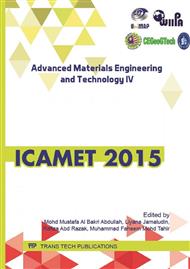[1]
Fu. X., Li. Q., Zhai. J., Sheng. G and Li. F. (2008). The physical–chemical characterization of mechanically-treated CFBC fly ash. Cement and Concrete Composites, 30(3), 220-226.
DOI: 10.1016/j.cemconcomp.2007.08.006
Google Scholar
[2]
Chindaprasirt. P, Jaturapitakkul. C., Chalee. W. and Rattanasak. U. (2009). Comparative study on the characteristics of fly ash and bottom ash geopolymers. Waste Management, 29(2), 539-543.
DOI: 10.1016/j.wasman.2008.06.023
Google Scholar
[3]
Temuujin. J, Williams R.P. and Van Riessen. A. (2009). Effect of mechanical activation of fly ash on the properties of geopolymer cured at ambient temperature. Journal of Materials Processing Technology, 209(12), 5276-5280.
DOI: 10.1016/j.jmatprotec.2009.03.016
Google Scholar
[4]
Kunjalukkal Padmanabhan. S. and Licciulli. A. (2014). Synthesis and characteristics of fly ash and bottom ash based geopolymers–A comparative study. Ceramics International, 40(2), 2965-2971.
DOI: 10.1016/j.ceramint.2013.10.012
Google Scholar
[5]
Boonserm. K., Sata. V., Pimraksa. K. and Chindaprasirt. P. (2012). Improved geopolymerization of bottom ash by incorporating fly ash and using waste gypsum as additive. Cement and Concrete Composites, 34(7), 819-824.
DOI: 10.1016/j.cemconcomp.2012.04.001
Google Scholar
[6]
Li. Q, Xu. H, Li. F, Li. P, Shen. L and Zhai. J. (2012). Synthesis of geopolymer composites from blends of CFBC fly and bottom ashes. Fuel, 97, 366-372.
DOI: 10.1016/j.fuel.2012.02.059
Google Scholar
[7]
Mathew. M.B. J, Sudhakar. M.M. and Natarajan. C. (2013). Strength, Economic and Sustainability Characteristics of Coal Ash–GGBS Based Geopolymer Concrete. International Journal of Computational Engineering Research, 3, 207-212.
Google Scholar
[8]
Xie. T. and Ozbakkaloglu. T. (2015). Behavior of low-calcium fly and bottom ash-based geopolymer concrete cured at ambient temperature. Ceramics International, 41(4), 5945-5958.
DOI: 10.1016/j.ceramint.2015.01.031
Google Scholar
[9]
Xie. T. and Ozbakkaloglu. T. (2015). Influence of coal ash properties on compressive behaviour of FA-and BA-based GPC. Magazine of Concrete Research, doi: 10. 1680/macr. 14. 00429.
DOI: 10.1680/macr.14.00429
Google Scholar
[10]
Chindaprasirt. P. and Rattanasak. U. (2010). Utilization of blended fluidized bed combustion (FBC) ash and pulverized coal combustion (PCC) fly ash in geopolymer. Waste Management, 30(4), 667-672.
DOI: 10.1016/j.wasman.2009.09.040
Google Scholar
[11]
Sinha. D.K., Kumar. A. and Kumar. S. (2014). Development of Geopolymer Concrete from Fly Ash and Bottom Ash Mixture. Transactions of the Indian Ceramic Society, 73(2), 143-148.
DOI: 10.1080/0371750x.2014.922427
Google Scholar


